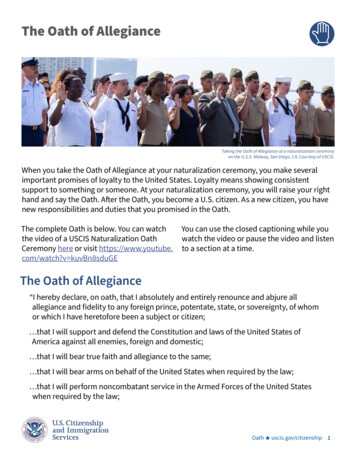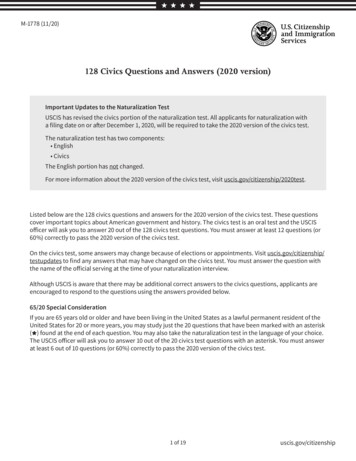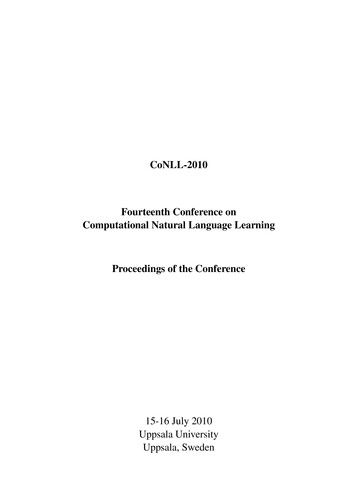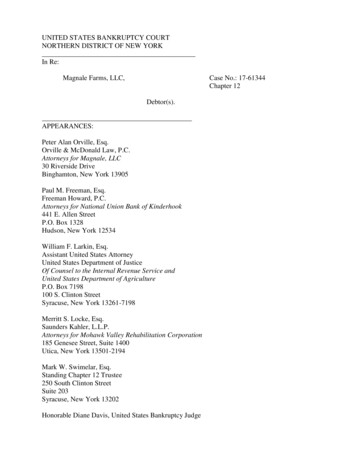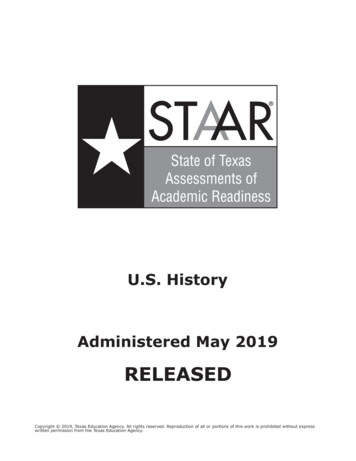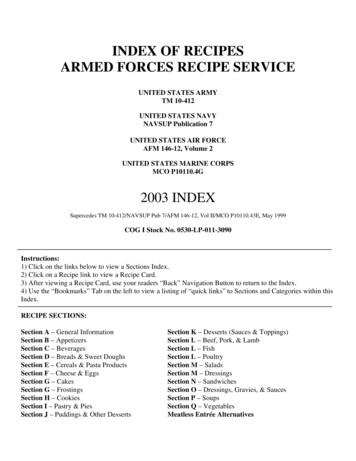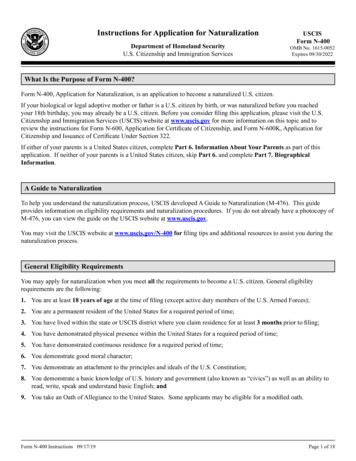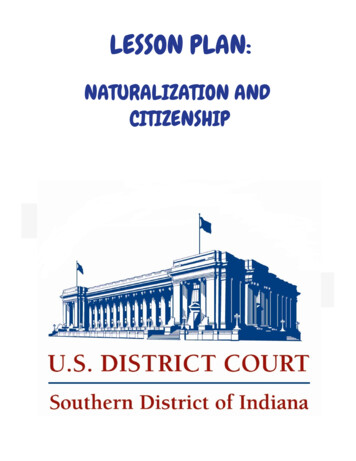
Transcription
LESSON PLAN:NATURALIZATION ANDCITIZENSHIP
This page intentionally left blank1
INTRODUCTIONThe United States District Court for the Southern District of Indiana is pleased to present this educational lessonplan on naturalization and citizenship. The lesson plan is designed to help teachers engage students in learningabout the naturalization process in the United States and the role of the federal courts in that process. Students willalso participate in meaningful conversation about the rights and responsibilities of citizenship.Teaching students about citizenship gives them the foundation to understand and participate in this country'sdemocratic society. Democracies require engaged, informed, and responsible citizens in order to thrive. Teachingstudents about naturalization helps them to value their status as citizens and involves them in critical thinking aboutthe benefits and duties that come with citizenship.GRADE LEVELS:This lesson plan can be adapted for middle school or high school use.INDIANA ACADEMIC STANDARDS:Middle School8.2 Civics and GovernmentHigh SchoolUnited States Government (USG) Standard 2: Foundations of Government in the United StatesUnited States Government (USG) Standard 3: Purposes, Principles and Institutions of Government in the UnitedStatesUnited States Government (USG) Standard 5: Roles of Citizens in the United StatesOBJECTIVES:After completing this lesson, a student should be able to:Discuss the rights and responsibilities of citizenshipKnow the meaning of key vocabulary termsUnderstand the naturalization process and the necessary steps that a foreign-born adultmust take to become a citizen of the United StatesExplain the history of immigration and naturalization in the United StatesIdentify the federal court's role in the naturalization process2
VOCABULARYALLEGIANCEJURISDICTIONLoyalty to a person or placeThe official power of an entity to make legaldecisions and judgmentsCITIZENA person who is legally recognized as a memberof a certain state or countryCITIZENSHIPThe status of having the rights, privileges, andduties of a legal member of a groupELLIS ISLANDA federally-owned inspection site in New Yorkthat was formerly used to process immigrantsarriving to the United StatesEMBASSYThe official place of business of an ambassador(official representative) to a foreign countryGREEN CARDThe document held by a permanent resident thatauthorizes them to reside indefinitely in theUnited StatesIMMIGRATIONThe act of permanently settling in a foreigncountryMIGRANT WORKERA person who temporarily moves to acountry in order to take a short-term job;many migrant workers in the United Stateswork as seasonal farm laborersNATIONALITYThe status of belonging to a country; theplace/culture that a person identifies withNATIVE CITIZENA person who was born in their country ofcitizenship, and who obtained theircitizenship upon birthNATURALIZATION CEREMONYThe event during which applicants forcitizenship swear the Oath of Allegiance tobecome citizens of the United StatesNATURALIZED CITIZENA person who immigrated to a country andthen later became a citizen of that country3
OATH OF ALLEGIANCEThe sworn declaration of loyalty that everyapplicant for United States citizenship mustmake publicly in order to become a citizenOPEN IMMIGRATIONFree movement from place to place with norestrictions on who may enterPERMANENT RESIDENTA person who is not a citizen of a country buthas been granted the legal right to live thereindefinitelyREFUGEEA person who has been forced to leave theirhome to escape persecution, violence, war, ornatural disasterVISAA document granting someone legal permissionto enter, leave, or stay in a country for aspecified time4
KEY CONCEPTSPART 1: CITIZENSHIPWHAT IS CITIZENSHIP?A citizen is a person who is a member of a country and has certain rights as a result of that membership. Inthe United States, people can become citizens either through birth (native citizens) or through a legal processof granting citizenship to foreign-born adults (naturalized citizen).Citizenship is the state of having been granted the rights and duties of a citizen. Citizenship comes from theLatin word for city because long ago, people identified themselves as citizens of cities rather than countries.WHAT ARE THE BENEFITS AND RESPONSIBILITIES OF UNITED STATES CITIZENSHIP?There are many benefits to being a citizen of the United States. They include:Obtaining a passport (so a person can travel outside of the United States without applyingfor a visa)Eligibility for assistance from a United States Embassy or Consulate when traveling outsideof the United StatesAbility to run for public officeEase of applying for, and obtaining, a job in the United StatesRight to vote in federal elections (note: this is a responsibility too!)Right to live abroad, but still return to the United States whenever you wishSafety from threat of deportationAccess to Social Security and Medicare benefitsAbility to sponsor close relatives to apply to become permanent residents of the UnitedStates without having to wait for a visaAlong with the rights of citizenship come responsibilities to the United States. They include:Giving up loyalty to your former home countrySwearing allegiance (loyalty) to the United StatesFollowing United States lawsVoting in federal electionsServing in the military, if calledServing on a juryRespecting the rights of othersPaying taxes5
WHO IS ELIGIBLE FOR CITIZENSHIP IN THE UNITED STATES?The eligibility requirements for citizenship in the United States are found in the United States Code Title 8: Aliensand Nationality. The United States Code is a collection of laws passed by Congress and signed into law by thePresident of the United States.People born in the United States automatically receive citizenship under United States law. There are also othercircumstances that allow a person to obtain citizenship from birth, including:If a person is born outside of the United States to two United States citizens, at least one of whomhas previously lived in the United StatesIf a person is born outside of the United States to one United States citizen and one non-citizen,provided that the United States citizen has lived in the United States for a total of five years ormore (including two years over the age of 14)Adults who were not born in the United States, but who hold a green card, may be eligible to become citizens ifthey meet the following criteria:Be 18 years of age or olderBe able to read, write, and speak basic English (or be exempt from this requirement if the person isage 50 or older and has lived in the United States for over 20 yearsHave a basic understanding of United States history and governmentHave lived in their current state of residence for at least three monthsHave not spent more than one year at a time outside of the United StatesHave resided in the United States continuously for at least five years as a permanent residentimmediately proceeding the date of filing their applicationHave been physically present in the United States for at least 30 months out of the five yearsimmediately proceeding the date of filing their applicationAre a person of good moral characterExpedited naturalization is available to certain groups of applicants, including spouses of American citizens andgovernment employees.Children under the age of 16 automatically become citizens when their parent is naturalized. Children betweenthe ages of 16 and 18 become citizens after their naturalized parent submits a petition on their behalf.6
PART 2: BECOMING A CITIZENHOW DOES A FOREIGN-BORN ADULT BECOME A CITIZEN OF THE UNITED STATES?If a foreign-born adult meets all of the eligibility criteria for citizenship and wishes to become a citizen of theUnited States, they must apply to the United States Citizenship and Immigration Service. To apply, the personmust fill out government form N-400 and pay a filing fee ranging from 640- 725.After submitting form N-400, applicants are fingerprinted. Their fingerprints are checked by the FBI to ensurethat applicants haven't committed a major crime.Applicants then move on to the interview stage. In the interview, applicants are asked basic questions aboutthemselves, their job, and their family. They are tested on their knowledge of basic American history andgovernment. There are 100 possible questions that an applicant may be asked. Applicants are given thequestions in advance to study. In the interview, 10 questions are chosen at random. To pass the test,applicants must get at least six questions correct. A test on the applicant's knowledge of basic English isalso administered (unless an exemption has been granted).If an individual passes the citizenship test, the applicant is scheduled to take the Oath of Allegiance in apublic ceremony. Citizenship is granted following recitation of the Oath of Allegiance.NATURALIZATION CEREMONIESPublic ceremonies during which prospective citizens take the Oath of Allegiance are referred to asnaturalization ceremonies. These ceremonies are festive occasions that often include friends and family.Ceremonies can be simple and short, mainly consisting of the Oath of Allegiance followed by distribution ofCertificates of Naturalization. Other ceremonies can be elaborate, including music, guest speakers, andspecial treats.All applicants for citizenship are required by federal law to recite the Oath of Allegiance in order to obtaincitizenship. The complete Oath of Allegiance states:I hereby declare, on oath, that I absolutely and entirely renounce and abjureall allegiance and fidelity to any foreign prince, potentate, state, orsovereignty, of whom or which I have heretofore been a subject or citizen;that I will support and defend the Constitution and laws of the UnitedStates of America against all enemies, foreign and domestic; that I willbear true faith and allegiance to the same; that I will bear arms on behalf ofthe United States when required by the law; that I will performnoncombatant service in the Armed Forces of the United States whenrequired by the law; that I will perform work of national importance undercivilian direction when required by the law; and that I take this obligationfreely, without any mental reservation or purpose of evasion; so help meGod.7
The basic principles of this oath are:Abandoning/leaving behind all loyalty to a person's previous country or leaderSupporting and defending the Constitution of the United StatesFollowing the principles set forth in the Constitution and obeying the country's lawsServing in the military, when required by lawPerforming civilian work of national importance when required by lawThere are two different branches of Federal Government that are allowed to naturalize new citizens.Officers of the United States Citizenship and Immigration Services (USCIS) can conduct naturalizationceremonies. Judges of the United States Federal Judiciary can also perform these ceremonies. If a newcitizen is requesting a name change, they must participate in a ceremony presided over by a federal judge.The United States District Court for the Southern District of Indiana performs about two naturalizationceremonies each month. Approximately 100 new citizens are naturalized in each of these ceremonies. TheIndianapolis Field Office of the USCIS (which covers the entire state of Indiana) naturalizes about 400additional new citizens each month.PART 3: HISTORICAL CONTEXTIMMIGRATION IN UNITED STATES HISTORYThe federal laws governing immigration today are much different than they were when this country wasfounded in 1776. In general, during the 18th and 19th centuries, Americans took a relaxed approach toimmigration, generally happy to encourage open immigration into the country.Following the Civil War, some states began to pass their own immigration laws, prompting the UnitedStates Supreme Court to declare in 1875 that laws governing immigration were within the exclusivejurisdiction of the federal government.In the 1880s, as the United States saw a sharp rise in immigration paired with a decline in its economy,Congress began passing laws governing immigration to the United States. These included the ChineseExclusion Act of 1882, the Alien Contract Labor Laws of 1885, and the Alien Contract Labor Laws of 1887.All three of these laws prohibited certain laborers from immigrating to the United States in an effort toprotect the jobs of American workers.The Immigration Act of 1882 passed further restrictions designed to regulate the type of immigrantsentering the country. The act required new immigrants to pay a tax of 50 cents upon arrival. It also deniedentry to a list of excluded persons, including those with mental illness, convicts, and those deemed unlikelyto be able to support themselves.Throughout most of the 19th century, states enforced immigration laws. The Immigration Act of 1891transferred responsibility for inspecting and admitting/rejecting immigrants to the federal government. Anew Immigration Services Bureau was created within the Department of Treasury. The law also expandedthe list of people who could not enter the United States to include those suffering from certain physicalillnesses.On January 2, 1892, the new Ellis Island immigration station opened in New York Harbor. It would quicklybecome the most famous port of entry into the country. Between 1892 and 1954, the station processedaround 12 million immigrants to the United States.8
The first 20 years of the 20th century (1900-1920) were characterized by a sharp rise in immigration tothe United States. This overwhelming influx of foreigners seeking a better life in America changed manyAmericans' historically welcoming attitudes towards new arrivals. Many of the nation's immigrationlaws were strengthened in response. The Immigration Act of 1917 required immigrants to take aliteracy test in their native language upon arrival. Rigorous medical exams were conducted at points ofdeparture. In 1921 and 1924, Congress passed its first quota laws, limiting the number of immigrantsby nationality. A limited number of visas were issued through United States Embassies worldwide. Onlythose immigrants who had obtained a visa were admitted to the United States.Following World War II, the United States government had to contend with another immigration issue war refugees. Congress passed laws such as the Displaced Persons Act of 1948 and the Refugee ReliefAct of 1953 to admit refugees from war-torn Europe outside of the quota system. A bill was alsopassed to aid the entrance of migrant workers who were coming from Mexico to take agricultural jobs.In 1965, the quota system based on national origin was replaced with a system designed to reunitefamilies and attract skilled workers. Another big change occurred in 1980, when Congress passed itsfirst uniform law regarding refugees. In 1990, Congress overhauled the entire immigration andnaturalization process. Most notably, the total number of visas available per year was increased by40%. The annual cap on immigration rose to 700,000. Today, Congress continues to work to create animmigration system that is fair to current citizens and new immigrants alike.NATURALIZATION IN UNITED STATES HISTORYIn 1790, the United States passed its first law governing naturalization. The Naturalization Act of 1790required applicants for citizenship to have resided in the United States for two years and to have lived intheir current state of residence for one year. The Naturalization Act of 1795 increased the requirementto five years of residency in the country and added the requirement that applicants provide a three-yearnotice of intent to become a naturalized citizen. In 1798, this requirement was increased to 14 years ofresidency, with five years of notice. The requirement reverted to five years of residency in 1802.In 1802, Congress passed a law stating that any court of record (state, federal, or municipal) couldnaturalize a new American citizen. This system made it difficult to confirm that a person had beennaturalized. It was more than 100 years before Congress remedied the situation. In 1906, Congresspassed the Basic Naturalization Act, which required naturalization petitions to be recorded onstandardized forms and placed their jurisdiction exclusively within the federal court system. A newlycreated Naturalization Service was responsible for collecting copies of naturalization certificates andplacing them in a centralized location.Throughout the 20th century, the naturalization process largely remained the same, except for a fewminor alterations and the addition of expedited processes for certain individuals. Most notably, in 1964,Congress passed a law allowing expedited naturalization for non-citizens who had served in the UnitedStates military.A major overhaul of the naturalization process occurred following the Immigration Act of 1990.Immigration and Naturalization Services (now called United States Citizenship and ImmigrationServices) officers were granted the authority to preside over naturalization ceremonies. The federaljudiciary continues to retain exclusive jurisdiction over petitions for naturalization that include a namechange request.9
HISTORY OF THE OATH OF ALLEGIANCEThe first recorded Oath of Allegiance in the United States was used during the Revolutionary War to gainvows of loyalty from new officers of the Continental Army. These officers were required to swear that theyhad given up all loyalty to the King of England, George III.In 1790, the Naturalization Act passed by Congress required applicants for citizenship to agree to "supportthe Constitution of the United States." In 1795, Congress added the requirement that applicants forcitizenship must renounce loyalty to the leader of their prior home country. It wasn't until 1906 thatlanguage was added requiring applicants for citizenship to swear allegiance to the Constitution and agreeto defend the Constitution against enemies.Between 1790 and 1929, courts that naturalized citizens each developed their own oath based on theabove requirements. In 1929, Immigration Services created a standardized oath for every court to use. Thesections of the oath requiring applicants to serve in the United States military (if called) and to performcivilian work of national importance were added in the 1950s.10
Further ReadingHISTORY AND FACTS:U.S. Citizenship and Immigration Services, "Overview of INS %20History/INSHistory.pdfUSCIS Naturalization Fact Sheet, ion-fact-sheetACTIVITIES AND LESSON PLAN IDEAS:iCivics, Citizenship & Participation Curriculum, icipationREFLECTIONS OF NEW CITIZENS:Angela Masajo, "Why I Became a U.S. Citizen," fa35d1?gi ab6238805309Sichao Ni, "Reflections of a Naturalized U.S. Citizen," zenVIDEOS OF NATURALIZATION CEREMONIES:U.S. Naturalization Ceremony at IUPUI (Full Ceremony - 1 hour),https://iu.mediaspace.kaltura.com/media/US Naturalization Ceremony at IUPUI/1 x9dmrcsoArizona Public Media, New Americans (Ceremony Recap - 10 min), https://www.youtube.com/watch?v j4HP S9mao11
CLASSROOM ACTIVITIES12
DISCUSSION QUESTIONS1) What does citizenship mean to you?2) What makes someone a good citizen?3) What are some of the privileges of citizenship? What are the responsibilities?4) What are some things that a person gains when immigrating to the United States andbecoming a citizen? What are some things that a person leaves behind?5) What are some reasons a person might decide to immigrate to the United States? What aresome reasons why an immigrant might decide to become a citizen?6) Do you know any naturalized citizens? What are they like?13
VOCABULARY QUIZ1) is the place/culture that a person identifies with, or the status of belongingto that place.2) A document granting someone legal permission to enter, leave, or stay in a country for a specifiedtime is known as a .3) A is a person who is legally recognized as a member of a country.4) The document held by a permanent resident that authorizes them to live indefinitely in the UnitedStates is known as a .5) The is a sworn declaration of loyalty that every applicant for United StatesCitizenship must make publicly.6) Loyalty to a person or place is known as .7) The act of permanently settling in a foreign country is known as .8) The status of having the rights, privileges, and responsibilities of legal membership in a group isknow as .9) A person who was born in their country of citizenship is a .10) is a famous former federal inspection site used to process immigrantsarriving to the United States.11) A is a person who immigrated to a country and then later became a citizen ofthat country.12) A person who has been forced to flee their home to escape persecution, violence, war, or naturaldisaster is known as a .WORD BANKVISAALLEGIANCEELLIS ISLANDREFUGEEGREEN CARDNATIVE CITIZENNATIONALITYIMMIGRATIONNATURALIZED CITIZENCITIZENSHIPOATH OF ALLEGIANCECITIZENTEACHERS - For an advanced version of this activity, omit the WORD BANK.14
STUDENT COMPREHENSION QUIZSHORT ANSWER1. Name four benefits of becoming a UnitedStates Citizen.2. Name four responsibilities of becoming aUnited States citizen.3. Name three eligibility requirements a personmust meet in order to apply for United Statescitizenship.4. List three steps an applicant must take tobecome a citizen of the United States.TRUE/FALSE1. The federal government has the exclusiveauthority to determine the country'simmigration laws.2. A person can claim citizenship from birth,even if born outside of the United States, if bothparents are United States citizens and oneparent has previously resided in the UnitedStates.4. Candidates for naturalization wishing to changetheir legal name can only be naturalized by a UnitedStates federal judge.5. In the citizen interview, applicants are asked 100questions about American history and government.They must get 90 answers correct to pass.MULTIPLE CHOICE1. Which of the following groups is currentlyauthorized to conduct naturalization ceremonies?A. federal judgesB. state court judgesC. United States Citizenship andImmigration ServicesD. both A and C2. Which of the following was a provision of theoriginal Oath of Allegiance authorized by Congressin 1790?A. renouncing loyaltyB. defending the United States againstenemiesC. supporting the ConstitutionD. all of the above3. To obtain a visa to immigrate to the UnitedStates, interested individuals must apply toA. United States CongressB. their nearest United States EmbassyC. the Office of the President of the UnitedStatesD. United States Citizenship andImmigration Services3. Children under the age of 18 who are notnative citizens of the United States can onlyobtain citizenship by waiting until they turn 18to apply.15
4. Which of the following is NOT a basic principleof the Oath of Allegiance?A. promising to serve in the military ifrequired by lawB. promising to never reside outside of theUnited StatesC. abandoning loyalty to a previous countryor leaderD. all of the above are included in the oath5. What was the first recorded use of an Oath ofAllegiance in the United States?A. to gain vows of loyalty from delegates tothe Constitutional ConventionB. to naturalize British prisoners of warfollowing the end of the Revolutionary WarC. to gain loyalty from new officers in theContinental ArmyD. none of the above6. The official source containing eligibilityrequirements for United States Citizenship is:A. the United States CodeB. the Rules of Federal ProcedureC. the Federal RegisterD. they are not formally documented7. Which of the following was a provision of thefirst Naturalization Act in United States history,passed in 1790?8. Quota laws were designed to:A. restrict the number of legal permanentresidents who could obtain citizenshipB. encourage open immigration into theUnited StatesC. limit the number of visas issued toimmigrants from a particular countryD. none of the above9. Approximately how many new citizens arenaturalized by the United States District Court forthe Southern District of Indiana each month?A. 200B. 600C. 400D. 5010. Which of the following was not a provision ofthe Immigration Act of 1882?A. new immigrants had to pay a 50-cent feeto enter the countryB. convicts were prohibited from enteringthe countryC. immigrants were required to swearloyalty to the country upon arrivalD. people without visible means to supportthemselves could be denied entry into thecountryA. applicants must have resided in the UnitedStates for two yearsB. applicants must have resided in theUnited States for one yearC. applicants must have resided in theUnited States for five yearsD. applicants must have resided in theUnited States for 14 years16
TEST YOUR KNOWLEDGE:How many citizenship test questions can you answer?Download the "Naturalization Test Questions & Answers" document found ces. Test your students' knowledge by:A. Asking them to complete the entire 100-question testB. Pulling 10 questions from the test to ask each student at random, similar to what prospective citizensactually experienceC. Breaking students into teams to answer as many questions as they can in a timedrace against other teams17
STUDENT ACTIVITY:Reflecting on the Oath of AllegianceI hereby declare, on oath, that I absolutely and entirely renounce andabjure all allegiance and fidelity to any foreign prince, potentate, state, orsovereignty, of whom or which I have heretofore been a subject orcitizen; that I will support and defend the Constitution and laws of theUnited States of America against all enemies, foreign and domestic; thatI will bear true faith and allegiance to the same; that I will bear arms onbehalf of the United States when required by the law; that I will performnoncombatant service in the Armed Forces of the United States whenrequired by the law; that I will perform work of national importance undercivilian direction when required by the law; and that I take this obligationfreely, without any mental reservation or purpose of evasion; so help meGod. Oath of Allegiance for United States CitizenshipReflection Questions (for discussion or essay):Imagine that you are an applicant for citizenship. How would you feel to make the promises required inthe Oath of Allegiance? Would it be difficult or easy? Why?Imagine that you moved to a new country. You settle there and decide that you will not return to theUnited States. Would you take an Oath of Allegiance like this to your new country? Why or why not?Imagine that you are a member of Congress, tasked with revising the Oath of Allegiance. What partswould you take out? What new additions would you make? Explain your choices.18
STUDENT PROJECT IDEASMake naturalization and citizenship concepts come to life with thesefun project ideas!1.Ask students to write a letter of welcome to new citizens of the United States. Encouragestudents to tell the new citizens what they value most about their citizenship.2.Have students write an essay reflecting on the topic of citizenship, and what it means tothem.3.Ask students to interview a naturalized citizen to learn about their experiences, culture,and why they chose to settle in the United States.4.Have students write a poem, story, or song about citizenship to perform in class.5.Attend a naturalization ceremony as a class. To make arrangements for your class toattend a naturalization ceremony hosted by the United States District Court for theSouthern District of Indiana, send an email to tours@insd.uscourts.gov.19
ANSWER KEYSTUDENT VOCABULARY QUIZ1) NATIONALITY2) VISA3) CITIZEN4) GREEN CARD5) OATH OF ALLEGIANCE6) ALLEGIANCE7) IMMIGRATION8) CITIZENSHIP9) NATIVE CITIZEN10) ELLIS ISLAND11) NATURALIZED CITIZEN12) REFUGEESTUDENT COMPREHENSION QUIZSHORT ANSWER1) CHOOSE FOUR: Obtain a passport, Obtainassistance from a U.S. Embassy or Consulatewhen traveling outside of the U.S., Run for publicoffice, Easier to obtain a U.S. job, Right to vote,Right to live abroad and return to the U.S. whenyou wish, Safety from deportation, Access toSocial Security and Medicare, Ability to sponsorclose relatives to become permanent residentsof the U.S.2)CHOOSE FOUR: Giving up loyalty to yourformer home country, swearing allegiance to theUnited States, following United States laws,Voting in federal elections, Serving in themilitary, Serving on a jury, Respecting the rightsof others, Paying taxes3) CHOOSE THREE: Be 18 years of age or older,Be able to read, write, and speak basic English,Have a basic understanding of United Stateshistory and government, Have lived in theircurrent state of residence for at least threemonths, Have not spent more than one year at atime outside of the United States, Have residedin the United States continuously for at leastfive years as a permanent resident immediatelyproceeding the date of filing their application;Have been physically present in the UnitedStates for at least 30 months out of the fiveyears immediately preceding their date of filingtheir application, Are a person of good moralcharacter4) CHOOSE THREE: Fill out form N-400; Pay afee of 640- 725; Submit to fingerprinting;Attend an interview consisting of basicquestions about themselves, a 10-question teston U.S. history and government, and an Englishtest; Recite the Oath of AllegianceTRUE/FALSE1)TRUE2)TRUE3)FALSE - they may obtain citizenship thro
Congress began passing laws governing immigration to the United States. These included the Chinese Exclusion Act of 1882, the Alien Contract Labor Laws of 1885, and the Alien Contract Labor Laws of 1887. All three of these laws prohibited certain laborers from immigrating to the United States in an effort


